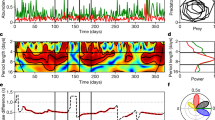Abstract
Techniques of time series analysis are applied to the dynamics of the phytophagous miteTetranychus urticae Koch and its predatorTyphlodromus occidentalis Nesbitt in six experimental mini-orchards, sampled weekly during two years (van de Klashorst et al., 1992). Autocovariance and crosscovariance functions characterize local and global behaviour in the time domain. Spectral density function and cross amplitude spectrum provide important information of the system's behaviour in the frequency domain. Because of a strikingly different behaviour, the total record was cut into two distinct periods. During the first period, all local systems oscillate with a frequency of four cycles per year and all in phase, resulting in a strongly periodical global behaviour at a high mean level. Since the mean local power spectra coincide with the global power spectrum over a wide range of frequencies, it is concluded that the total system of six orchards is homogeneous. During the second period, all local power spectra are mutually different, more or less smoothed with no apparent peak pointing to a periodical component. The resulting global power spectrum is almost flat at a low mean level. The system is heterogeneous with a quasi-stable global behaviour.
From the cross-amplitude spectrum it became clear that the dynamics of the two species within the orchards remained strongly coupled over a wide range of frequencies.
Since the experimental circumstances had not been intentionally changed, the origin of the drastic change in behaviour could not be identified. If high rates of dispersal have been the synchronizer during the first period, it is not clear why asynchrony suddenly occured in the second period.
A comparison of the overall record with the results of Nachman's (1987) stochastic simulation model suggests that the change could possibly be of stochastic origin.
Similar content being viewed by others
References
Box, G.E.P. and Jenkins, G.M. 1976. Time Series Analysis, Forecasting and Control. Holden-Day, San Francisco, CA, 575 pp.
Jenkins, G.M. and Watts, D.G., 1968. Spectral Analysis and its Applications. Holden-Day, San Francisco, CA, 525 pp.
Lingeman, R., 1981. Signal analysis of irradiation, temperature and primary production in a small artificial pond: II. The residual spectra. Int. Rev. Gesamten Hydrobiol., 66: 203–222.
Nachman, G., 1987. Systems analysis of acarine predator-prey interactions. II. The role of spatial processes in system stability. J. Anim. Ecol., 56: 267–281.
Platt, T. and Denman, K.L., 1975. Spectral analysis in ecology. Ann. Rev. Ecol. Syst., 6: 189–210.
Powell, T.M., 1989. Physical and biological scales of variability in lakes, estuaries, and the coastal ocean. In: J. Roughgarden, R.M. May and S.A. Levin (Editors), Perspectives in Ecological Theory. Princeton University Press, Princeton, NJ, pp. 157–176.
Van de Klashorst, G., Readshaw, J.L., Sabelis, M.W. and Lingeman, R., 1992. A demonstration of asynchronous local cycles in an acarine predator-prey system. Exp. Appl. Acarol., 14: 185–199.
Author information
Authors and Affiliations
Rights and permissions
About this article
Cite this article
Lingeman, R., van de Klashorst, G. Local and global cycles in an acarine predator-prey system: a frequency domain analysis. Exp Appl Acarol 14, 201–214 (1992). https://doi.org/10.1007/BF01200564
Issue Date:
DOI: https://doi.org/10.1007/BF01200564




